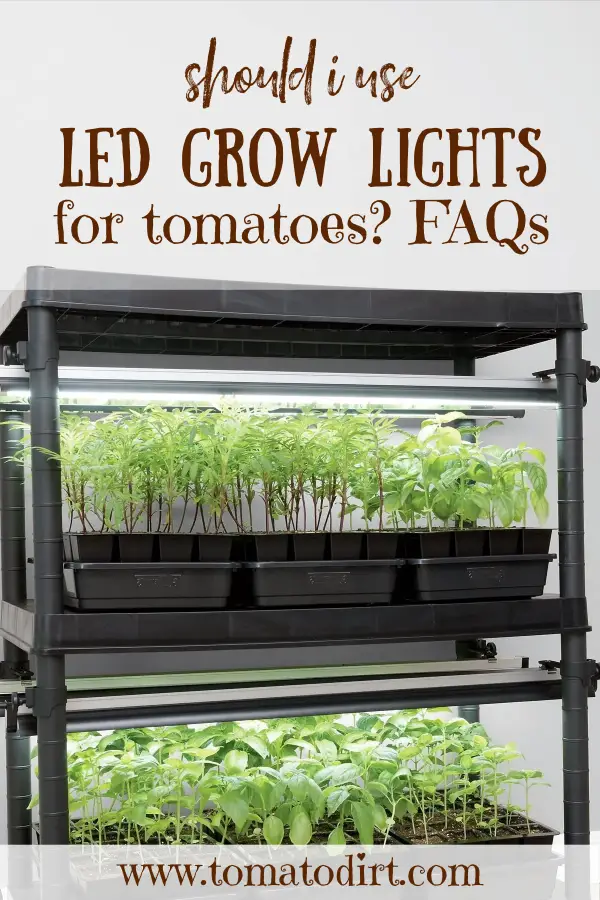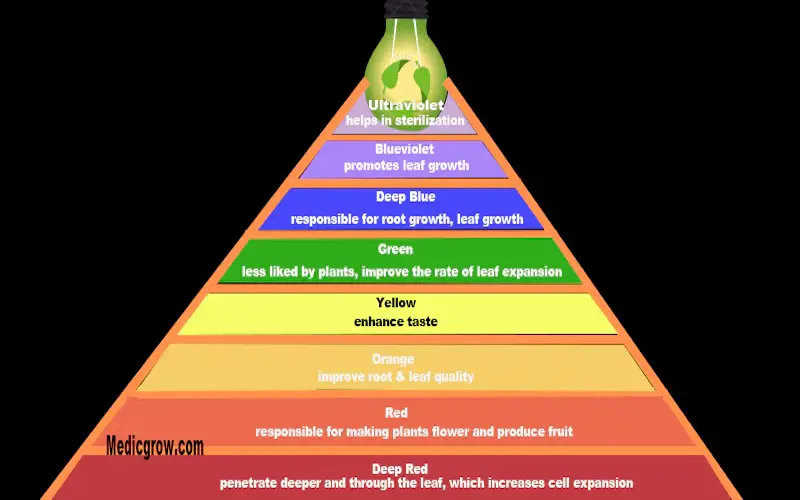FREE: 10 Must-Know Tomato Growing Tips Get The Guide
Read our affiliate disclosure here.
Should I use LED grow lights for tomatoes? FAQs
Since 2010, Tomato Dirt has garnered 4.8+ million views, making it the web’s leading online source for growing tomatoes in the home garden. Award-winning writer and Tomato Dirt owner Kathy Widenhouse has helped thousands of home gardeners grow healthier tomatoes. Be one of them when you get Tomato Dirt’s Growing Guide here.
LED grow lights are used for growing seedlings and plants indoors. The “LED” acronym is short for Light Emitting Diode. In layman’s terms, that means an LED is a device that converts electricity directly into light.
LEDs are becoming a preferred grow light among home gardeners because they are so efficient. If you would like to start seeds indoors or even grow indoor tomatoes, you may want to consider using LED grow lights. (Here are other grow light options to consider, too.)
But first, here’s the dirt about what plants need from grow lights. This information can help you understand why LED grow lights are a good choice for growing tomato seedlings and plants indoors.

What kind of light do indoor tomatoes need?
Indoor plants grow best with light that is as similar as possible to natural sunlight. As you may remember from your school days, light is made up of waves.
Light waves are tinted on a spectrum ranging from red/orange/yellow waves (defined as “warm tint”) to blue/violet waves (“cool tint”). Each type of light—warm or cool—encourages specific plant behavior. Light waves are measured in numerical values on the Kelvin color temperature scale, like this:
- Red/orange/yellow: 1,000K—4,000 K. Red light waves help plants flower, produce fruit, and enhance taste.
- Bright white to green: 4,000—7,000 K. White to green light allow plants to expand foliage.
- Blue/violet: 7,000—10,000 K. Blue light promotes root and leaf growth.
It’s no secret that along with light, plants need water, food, and air circulation to grow their best. As for light, plants need a full spectrum of 2,700 to 6,500 degrees Kelvin to grow their healthiest.
LED grow light FAQs
How do LED grow lights work for tomatoes?
The first LED grow lights emitted a narrow spectrum of light. Some LEDs offered light on the warm end of the continuum, others in the blue range. Gardeners needed blue LEDs to get seedlings started, because blue light waves promote root and leaf growth. Once the seedlings got large enough, gardeners switched to red LED grow lights to provide what the plants needed in order to mature. Red light helps plants to flower and produce fruit.
But now, with technological advances, full spectrum LED lights are available for the home gardener. There’s no need to change out LED grow lights (although some gardeners still prefer to do so.) Today’s LED grow lights offer the full range of color temperature wavelengths that are closest to natural light.
Is there a difference between LED lights and LED grow lights?
Yes. Standard LED lights offer a limited spectrum of wavelengths, which is fine for the lights in your bedroom or living room. But LED grow lights are different. They have a wider spectrum of both blue (cool) and red (warm) light to promote both vegetative growth and flowering/fruiting. When you choose LED lights for indoor growing, make sure you select those that are purposely manufactured for plants.
Can any LED light be used as a grow light?
You can use any type of LED light to grow indoor plants, but only LED grow lights are most effective because they offer a full spectrum of color.
The impact of light wave color on plant growth
What are the advantages of LED grow lights?
Gardeners have plenty of grow light options. But when compared with fluorescent and HID grow lights, LED grow lights have some distinct advantages.
- Efficiency. While LEDs are a bit more expensive to purchase, they use less power than other grow lights. They also last up to five times longer – up to 50,000 hours compared to an average of 10,000 hours for fluorescents and HIDs. That makes LEDs much less expensive than other grow lights in the long run. In fact, a recent report from the U.S. Department of Energy found you could save up to 75% in energy costs by using LED lights over other types.
- Full spectrum light. Today’s LED grow lights emit the full color wave spectrum. If you choose to grow tomatoes or other crops indoors, LED lights provide what plants need to grow throughout their life cycle.
- Temperature. LEDs emit less heat than other grow lights. Lower temperatures mean less heat risk and burn risk for plants. Plants can grow closer to the lights than with other types of bulbs – as close as 6 inches to LEDs – and be safe. That means LED systems take less space, which provides more …
- Size options. LED light systems are available in a variety of sizes, from the most compact tabletop versions to entire greenhouse structures. That’s good news for the home gardener, especially those with limited space. If you’ve ever wondered whether you can start tomato seeds in your apartment or in other small space, the answer is “Yes! With LEDs!”
What are the disadvantages of LED grow lights?
Like any artificial light system, LED grow lights have a few drawbacks.
- Initial cost. You need to spend a bit more on an LED grow light system than for HIDs or fluorescents. However, it won’t be long until your LED grow lights recoup those upfront costs because they are so efficient.
- Power. LEDs’ efficiency has a downside – these bulbs are less powerful than other grow lights. That’s why you should choose LED bulbs that are specifically created for growing systems. Standard LED lights offer a limited light spectrum.
- Eye strain. LEDs offer the full spectrum of color wavelengths, which includes blue light. Your retina is sensitive to blue light waves. Experienced gardeners limit their exposure to LED grow lights by placing their systems in a less-trafficked area of the home or by using blue light filtering glasses.
What LED light is best for growing plants?
Look for “full spectrum” LED grow lights. The most typical color temperature is about 6,500 Kelvin, which is the usual color temperature in natural daylight.
As for size, choose a bulb that fits your grow light system. The most common are T5 and T8 bulbs, in which the "T" refers to a tubular shape. The number indicates the bulb’s diameter in eighths of an inch, making a T5 bulb 5/8 of an inch in diameter and a T8 bulb 8/8 – a full inch in diameter.
Is LED light good for indoor plants?
Nothing beats natural outdoor light for outdoor crops. But if you want to start tomato seeds indoors or even grow an offseason crop inside, then LEDs are an excellent choice.
LED grow lights are efficient. They offer a full spectrum of light color wavelengths, which imitates natural daylight. And they are available as tubes for trays or as bulbs for specific plants. It’s no wonder that so many home gardeners are choosing LED grow lights for their indoor growing systems.
More Tomato Grow Light Tips
Choosing a grow light system for growing tomatoes from seed ...
Tomato grow lights for seedlings: frequently asked questions ...
Tomato grow lights explained ...
Using fluorescent grow lights to start seeds, grow tomatoes ...
Fluorescent grow light systems to choose from
...
Growing indoor tomatoes FAQs: Frequently Asked Questions...
See more tips on our Indoor Tomatoes Pinterest Board...
Return from LED Grow Lights for Tomatoes to Tomato Dirt home
As an Amazon Associate and Rakuten Advertising affiliate I earn from qualifying purchases.
SHARE THIS PAGE:
FREE! 10 Must-Know Tomato Growing Tips: 20-page guide
Get yours here:




